Managerial Economics Assignment: Discounting, Elasticity, and Leaders
VerifiedAdded on 2022/10/14
|15
|3239
|10
Homework Assignment
AI Summary
This Managerial Economics assignment delves into several key concepts. The first question assesses the importance of the discounting rate in investment decisions, calculating Net Present Value (NPV) to determine the worth of a warranty. The second question analyzes the impact of sugar import restrictions and corn syrup substitution on market equilibrium. The third question explores own-price and cross-price elasticity of demand, calculating elasticity and interpreting the results for a given demand function. The final section examines the business approaches and risk-taking behavior of J.P. Morgan and Andrew Dale Carnegie, highlighting their strategies in building financial and steel empires, respectively. The assignment utilizes formulas, calculations, and case studies to illustrate economic principles and business practices.
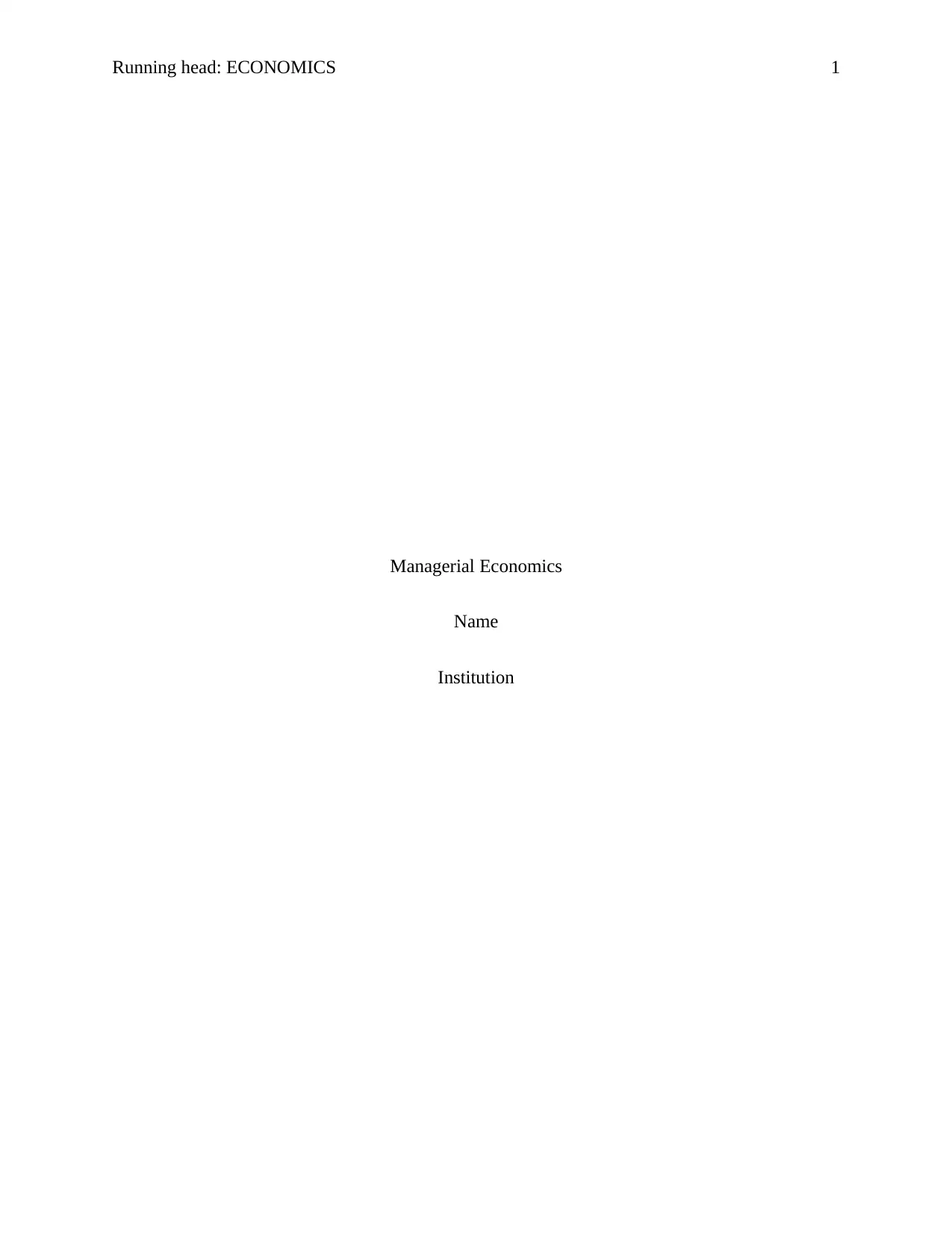
Running head: ECONOMICS 1
Managerial Economics
Name
Institution
Managerial Economics
Name
Institution
Paraphrase This Document
Need a fresh take? Get an instant paraphrase of this document with our AI Paraphraser
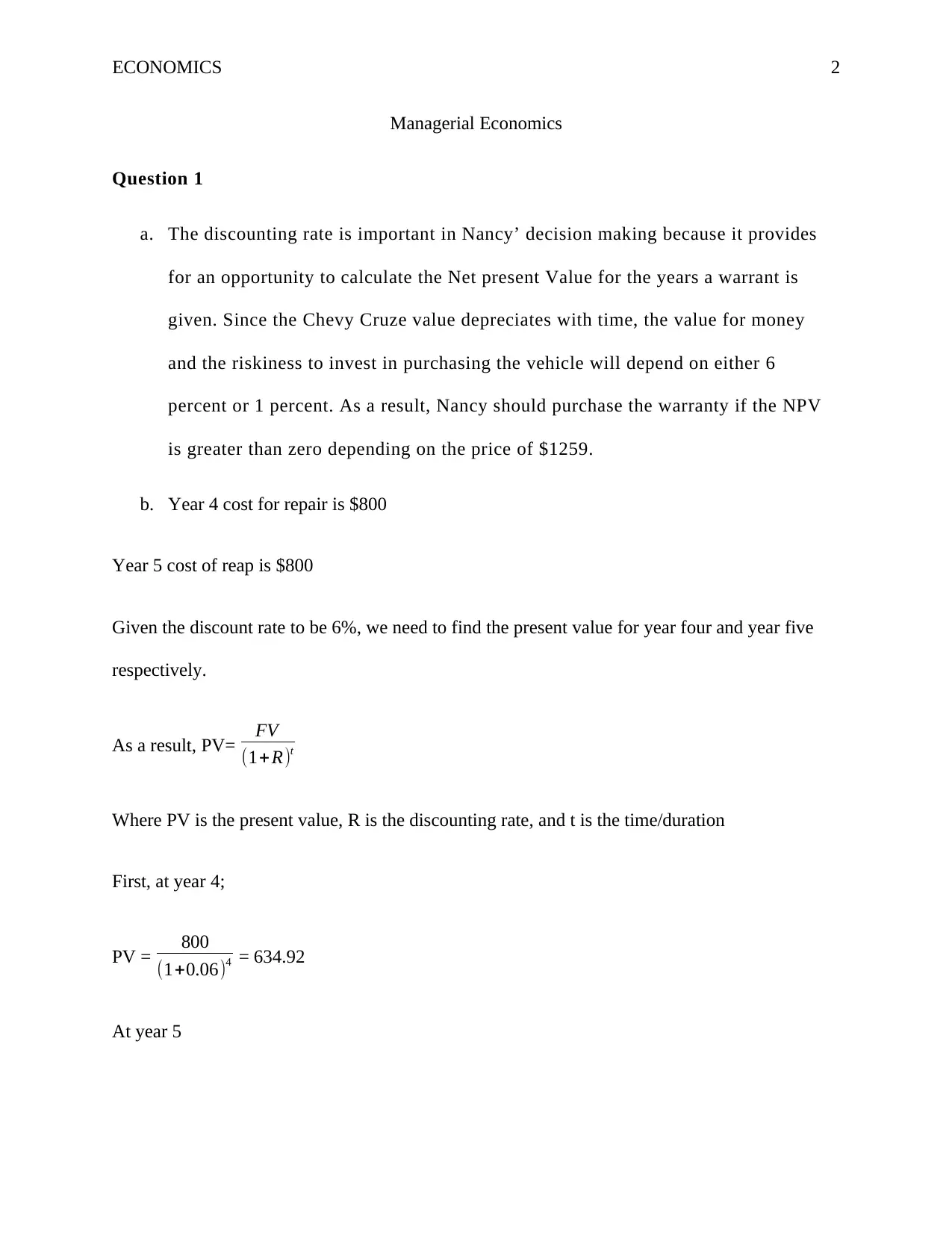
ECONOMICS 2
Managerial Economics
Question 1
a. The discounting rate is important in Nancy’ decision making because it provides
for an opportunity to calculate the Net present Value for the years a warrant is
given. Since the Chevy Cruze value depreciates with time, the value for money
and the riskiness to invest in purchasing the vehicle will depend on either 6
percent or 1 percent. As a result, Nancy should purchase the warranty if the NPV
is greater than zero depending on the price of $1259.
b. Year 4 cost for repair is $800
Year 5 cost of reap is $800
Given the discount rate to be 6%, we need to find the present value for year four and year five
respectively.
As a result, PV= FV
(1+ R)t
Where PV is the present value, R is the discounting rate, and t is the time/duration
First, at year 4;
PV = 800
(1+0.06)4 = 634.92
At year 5
Managerial Economics
Question 1
a. The discounting rate is important in Nancy’ decision making because it provides
for an opportunity to calculate the Net present Value for the years a warrant is
given. Since the Chevy Cruze value depreciates with time, the value for money
and the riskiness to invest in purchasing the vehicle will depend on either 6
percent or 1 percent. As a result, Nancy should purchase the warranty if the NPV
is greater than zero depending on the price of $1259.
b. Year 4 cost for repair is $800
Year 5 cost of reap is $800
Given the discount rate to be 6%, we need to find the present value for year four and year five
respectively.
As a result, PV= FV
(1+ R)t
Where PV is the present value, R is the discounting rate, and t is the time/duration
First, at year 4;
PV = 800
(1+0.06)4 = 634.92
At year 5
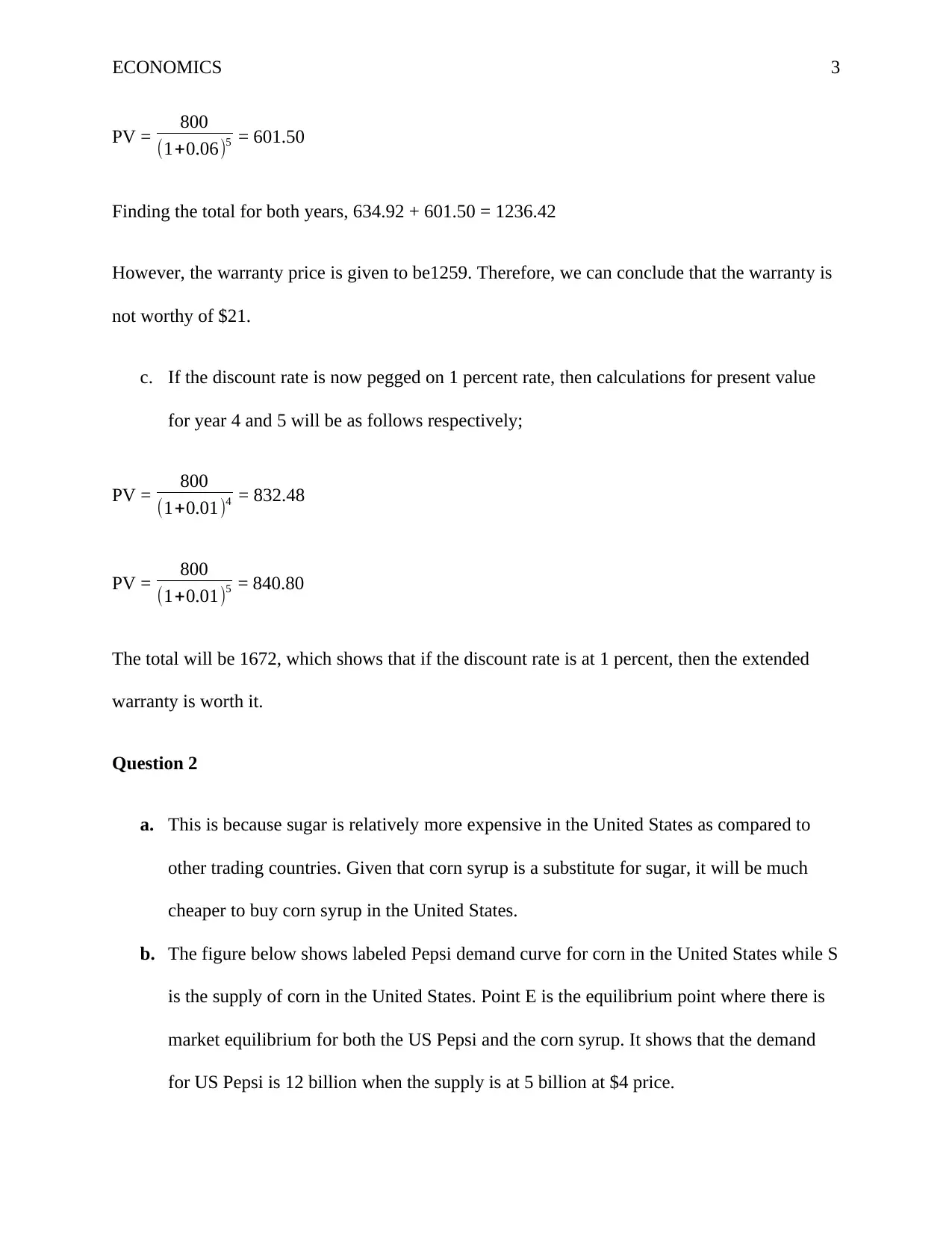
ECONOMICS 3
PV = 800
(1+0.06)5 = 601.50
Finding the total for both years, 634.92 + 601.50 = 1236.42
However, the warranty price is given to be1259. Therefore, we can conclude that the warranty is
not worthy of $21.
c. If the discount rate is now pegged on 1 percent rate, then calculations for present value
for year 4 and 5 will be as follows respectively;
PV = 800
(1+0.01)4 = 832.48
PV = 800
(1+0.01)5 = 840.80
The total will be 1672, which shows that if the discount rate is at 1 percent, then the extended
warranty is worth it.
Question 2
a. This is because sugar is relatively more expensive in the United States as compared to
other trading countries. Given that corn syrup is a substitute for sugar, it will be much
cheaper to buy corn syrup in the United States.
b. The figure below shows labeled Pepsi demand curve for corn in the United States while S
is the supply of corn in the United States. Point E is the equilibrium point where there is
market equilibrium for both the US Pepsi and the corn syrup. It shows that the demand
for US Pepsi is 12 billion when the supply is at 5 billion at $4 price.
PV = 800
(1+0.06)5 = 601.50
Finding the total for both years, 634.92 + 601.50 = 1236.42
However, the warranty price is given to be1259. Therefore, we can conclude that the warranty is
not worthy of $21.
c. If the discount rate is now pegged on 1 percent rate, then calculations for present value
for year 4 and 5 will be as follows respectively;
PV = 800
(1+0.01)4 = 832.48
PV = 800
(1+0.01)5 = 840.80
The total will be 1672, which shows that if the discount rate is at 1 percent, then the extended
warranty is worth it.
Question 2
a. This is because sugar is relatively more expensive in the United States as compared to
other trading countries. Given that corn syrup is a substitute for sugar, it will be much
cheaper to buy corn syrup in the United States.
b. The figure below shows labeled Pepsi demand curve for corn in the United States while S
is the supply of corn in the United States. Point E is the equilibrium point where there is
market equilibrium for both the US Pepsi and the corn syrup. It shows that the demand
for US Pepsi is 12 billion when the supply is at 5 billion at $4 price.
⊘ This is a preview!⊘
Do you want full access?
Subscribe today to unlock all pages.

Trusted by 1+ million students worldwide
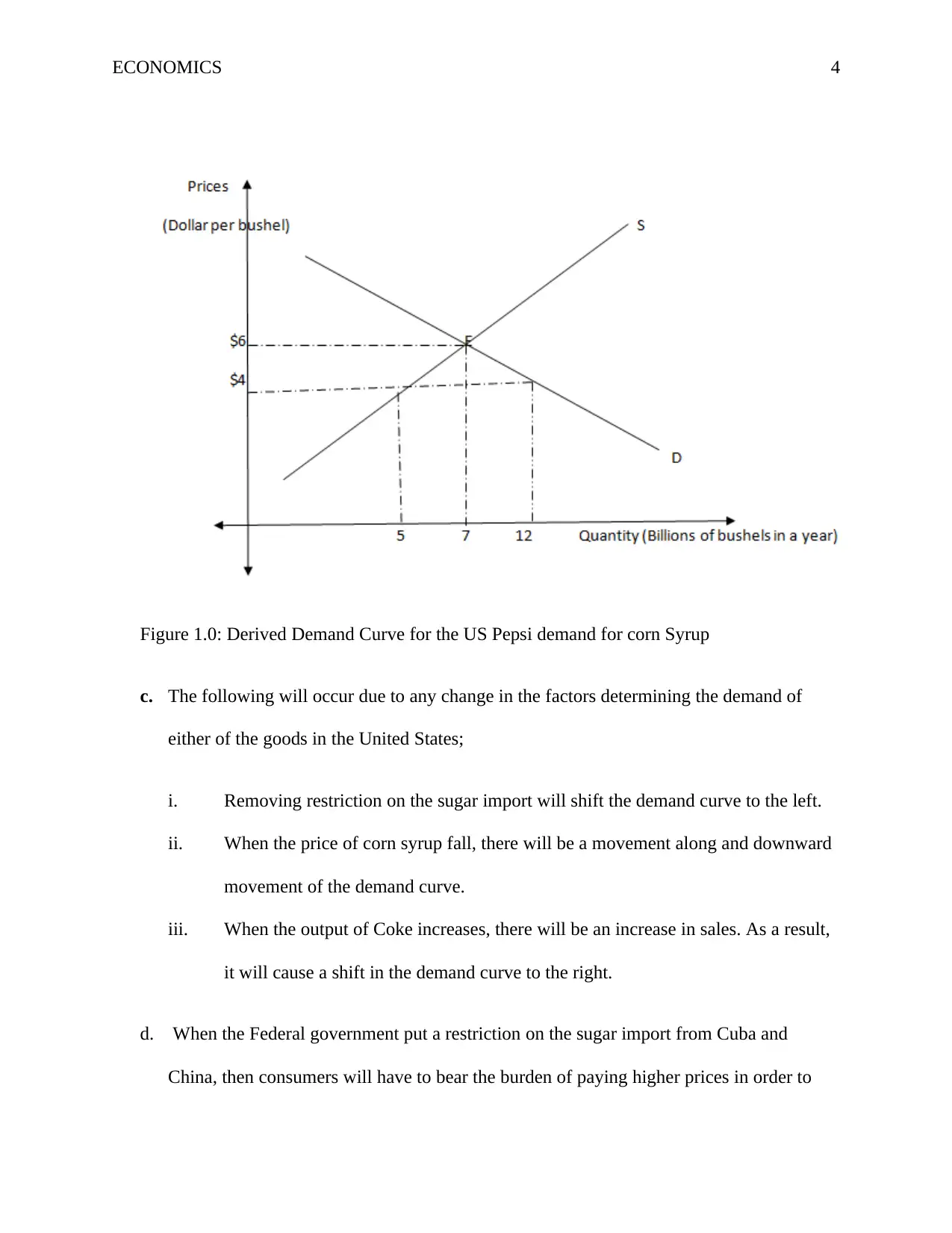
ECONOMICS 4
Figure 1.0: Derived Demand Curve for the US Pepsi demand for corn Syrup
c. The following will occur due to any change in the factors determining the demand of
either of the goods in the United States;
i. Removing restriction on the sugar import will shift the demand curve to the left.
ii. When the price of corn syrup fall, there will be a movement along and downward
movement of the demand curve.
iii. When the output of Coke increases, there will be an increase in sales. As a result,
it will cause a shift in the demand curve to the right.
d. When the Federal government put a restriction on the sugar import from Cuba and
China, then consumers will have to bear the burden of paying higher prices in order to
Figure 1.0: Derived Demand Curve for the US Pepsi demand for corn Syrup
c. The following will occur due to any change in the factors determining the demand of
either of the goods in the United States;
i. Removing restriction on the sugar import will shift the demand curve to the left.
ii. When the price of corn syrup fall, there will be a movement along and downward
movement of the demand curve.
iii. When the output of Coke increases, there will be an increase in sales. As a result,
it will cause a shift in the demand curve to the right.
d. When the Federal government put a restriction on the sugar import from Cuba and
China, then consumers will have to bear the burden of paying higher prices in order to
Paraphrase This Document
Need a fresh take? Get an instant paraphrase of this document with our AI Paraphraser
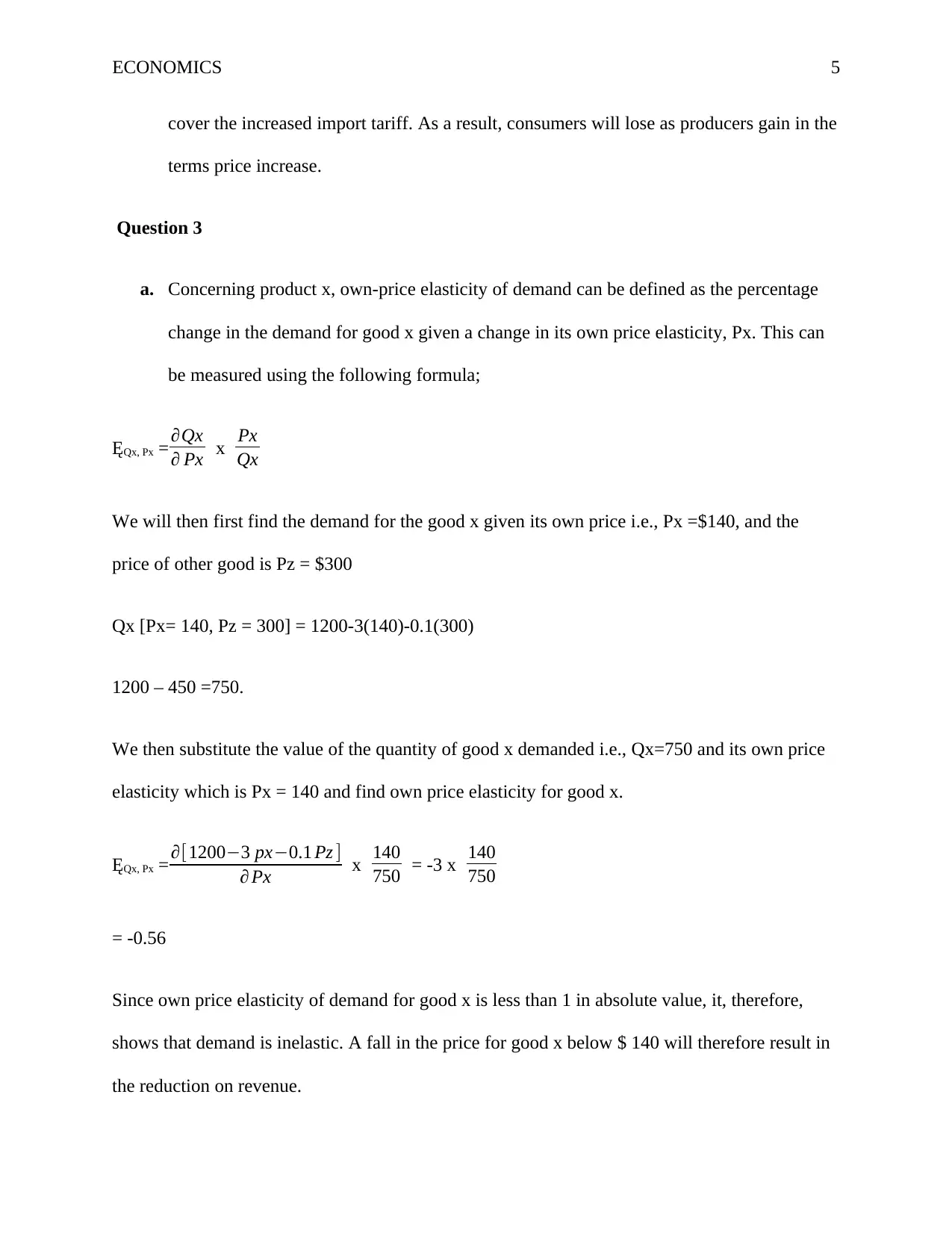
ECONOMICS 5
cover the increased import tariff. As a result, consumers will lose as producers gain in the
terms price increase.
Question 3
a. Concerning product x, own-price elasticity of demand can be defined as the percentage
change in the demand for good x given a change in its own price elasticity, Px. This can
be measured using the following formula;
ĘQx, Px = ∂Qx
∂ Px x Px
Qx
We will then first find the demand for the good x given its own price i.e., Px =$140, and the
price of other good is Pz = $300
Qx [Px= 140, Pz = 300] = 1200-3(140)-0.1(300)
1200 – 450 =750.
We then substitute the value of the quantity of good x demanded i.e., Qx=750 and its own price
elasticity which is Px = 140 and find own price elasticity for good x.
ĘQx, Px = ∂[1200−3 px−0.1 Pz ]
∂ Px x 140
750 = -3 x 140
750
= -0.56
Since own price elasticity of demand for good x is less than 1 in absolute value, it, therefore,
shows that demand is inelastic. A fall in the price for good x below $ 140 will therefore result in
the reduction on revenue.
cover the increased import tariff. As a result, consumers will lose as producers gain in the
terms price increase.
Question 3
a. Concerning product x, own-price elasticity of demand can be defined as the percentage
change in the demand for good x given a change in its own price elasticity, Px. This can
be measured using the following formula;
ĘQx, Px = ∂Qx
∂ Px x Px
Qx
We will then first find the demand for the good x given its own price i.e., Px =$140, and the
price of other good is Pz = $300
Qx [Px= 140, Pz = 300] = 1200-3(140)-0.1(300)
1200 – 450 =750.
We then substitute the value of the quantity of good x demanded i.e., Qx=750 and its own price
elasticity which is Px = 140 and find own price elasticity for good x.
ĘQx, Px = ∂[1200−3 px−0.1 Pz ]
∂ Px x 140
750 = -3 x 140
750
= -0.56
Since own price elasticity of demand for good x is less than 1 in absolute value, it, therefore,
shows that demand is inelastic. A fall in the price for good x below $ 140 will therefore result in
the reduction on revenue.
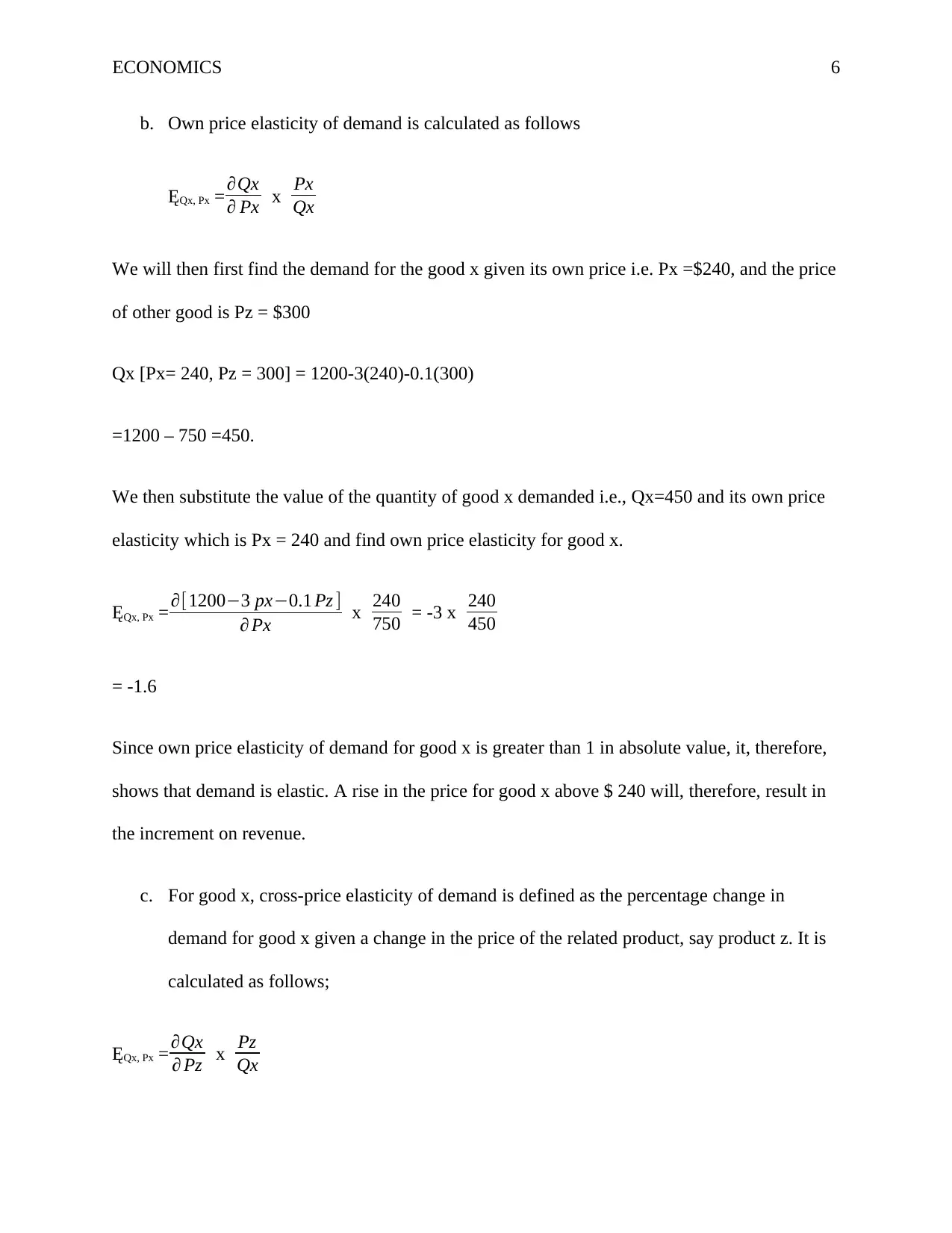
ECONOMICS 6
b. Own price elasticity of demand is calculated as follows
ĘQx, Px = ∂Qx
∂ Px x Px
Qx
We will then first find the demand for the good x given its own price i.e. Px =$240, and the price
of other good is Pz = $300
Qx [Px= 240, Pz = 300] = 1200-3(240)-0.1(300)
=1200 – 750 =450.
We then substitute the value of the quantity of good x demanded i.e., Qx=450 and its own price
elasticity which is Px = 240 and find own price elasticity for good x.
ĘQx, Px = ∂[1200−3 px−0.1 Pz ]
∂ Px x 240
750 = -3 x 240
450
= -1.6
Since own price elasticity of demand for good x is greater than 1 in absolute value, it, therefore,
shows that demand is elastic. A rise in the price for good x above $ 240 will, therefore, result in
the increment on revenue.
c. For good x, cross-price elasticity of demand is defined as the percentage change in
demand for good x given a change in the price of the related product, say product z. It is
calculated as follows;
ĘQx, Px = ∂Qx
∂ Pz x Pz
Qx
b. Own price elasticity of demand is calculated as follows
ĘQx, Px = ∂Qx
∂ Px x Px
Qx
We will then first find the demand for the good x given its own price i.e. Px =$240, and the price
of other good is Pz = $300
Qx [Px= 240, Pz = 300] = 1200-3(240)-0.1(300)
=1200 – 750 =450.
We then substitute the value of the quantity of good x demanded i.e., Qx=450 and its own price
elasticity which is Px = 240 and find own price elasticity for good x.
ĘQx, Px = ∂[1200−3 px−0.1 Pz ]
∂ Px x 240
750 = -3 x 240
450
= -1.6
Since own price elasticity of demand for good x is greater than 1 in absolute value, it, therefore,
shows that demand is elastic. A rise in the price for good x above $ 240 will, therefore, result in
the increment on revenue.
c. For good x, cross-price elasticity of demand is defined as the percentage change in
demand for good x given a change in the price of the related product, say product z. It is
calculated as follows;
ĘQx, Px = ∂Qx
∂ Pz x Pz
Qx
⊘ This is a preview!⊘
Do you want full access?
Subscribe today to unlock all pages.

Trusted by 1+ million students worldwide
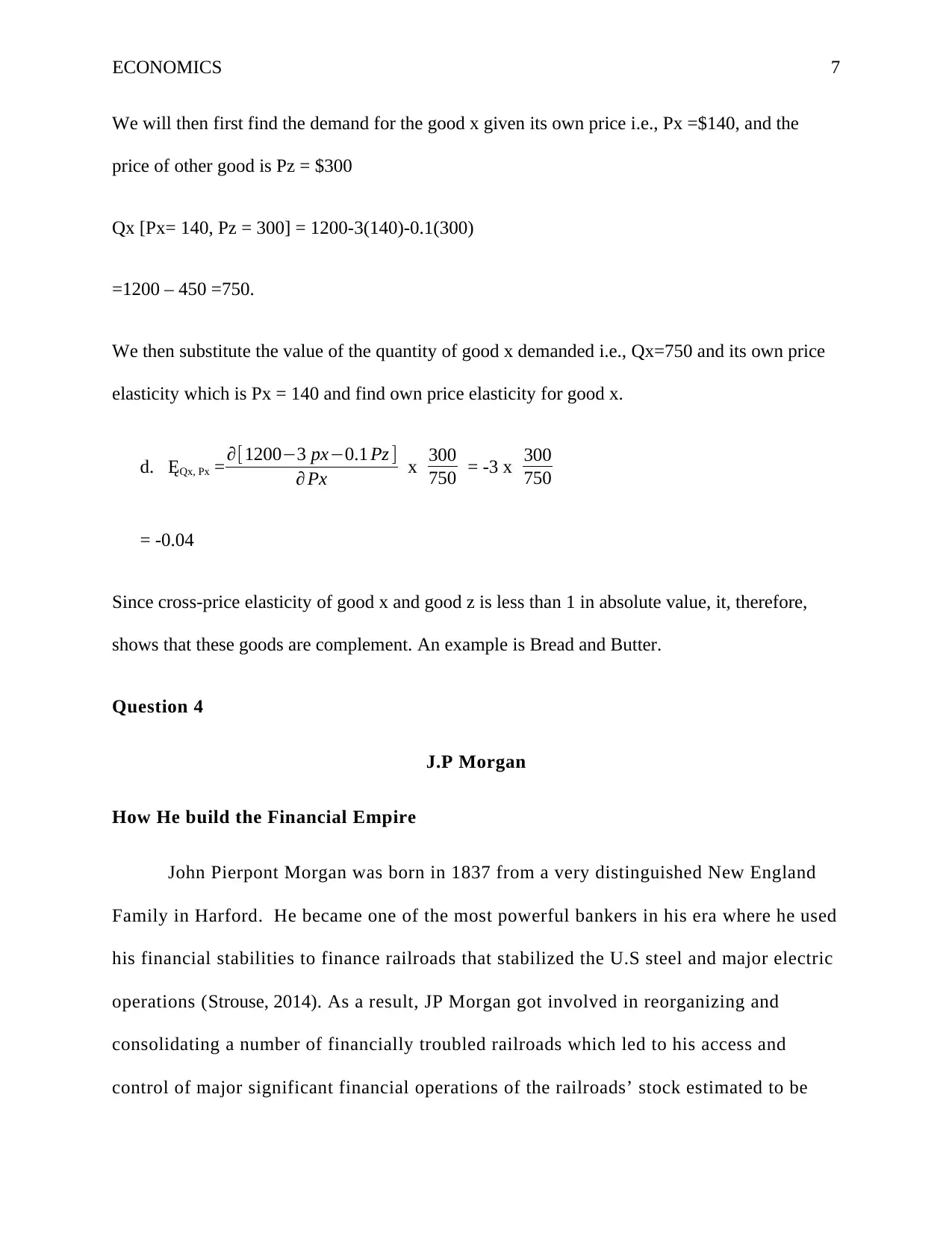
ECONOMICS 7
We will then first find the demand for the good x given its own price i.e., Px =$140, and the
price of other good is Pz = $300
Qx [Px= 140, Pz = 300] = 1200-3(140)-0.1(300)
=1200 – 450 =750.
We then substitute the value of the quantity of good x demanded i.e., Qx=750 and its own price
elasticity which is Px = 140 and find own price elasticity for good x.
d. ĘQx, Px = ∂[1200−3 px−0.1 Pz ]
∂ Px x 300
750 = -3 x 300
750
= -0.04
Since cross-price elasticity of good x and good z is less than 1 in absolute value, it, therefore,
shows that these goods are complement. An example is Bread and Butter.
Question 4
J.P Morgan
How He build the Financial Empire
John Pierpont Morgan was born in 1837 from a very distinguished New England
Family in Harford. He became one of the most powerful bankers in his era where he used
his financial stabilities to finance railroads that stabilized the U.S steel and major electric
operations (Strouse, 2014). As a result, JP Morgan got involved in reorganizing and
consolidating a number of financially troubled railroads which led to his access and
control of major significant financial operations of the railroads’ stock estimated to be
We will then first find the demand for the good x given its own price i.e., Px =$140, and the
price of other good is Pz = $300
Qx [Px= 140, Pz = 300] = 1200-3(140)-0.1(300)
=1200 – 450 =750.
We then substitute the value of the quantity of good x demanded i.e., Qx=750 and its own price
elasticity which is Px = 140 and find own price elasticity for good x.
d. ĘQx, Px = ∂[1200−3 px−0.1 Pz ]
∂ Px x 300
750 = -3 x 300
750
= -0.04
Since cross-price elasticity of good x and good z is less than 1 in absolute value, it, therefore,
shows that these goods are complement. An example is Bread and Butter.
Question 4
J.P Morgan
How He build the Financial Empire
John Pierpont Morgan was born in 1837 from a very distinguished New England
Family in Harford. He became one of the most powerful bankers in his era where he used
his financial stabilities to finance railroads that stabilized the U.S steel and major electric
operations (Strouse, 2014). As a result, JP Morgan got involved in reorganizing and
consolidating a number of financially troubled railroads which led to his access and
control of major significant financial operations of the railroads’ stock estimated to be
Paraphrase This Document
Need a fresh take? Get an instant paraphrase of this document with our AI Paraphraser
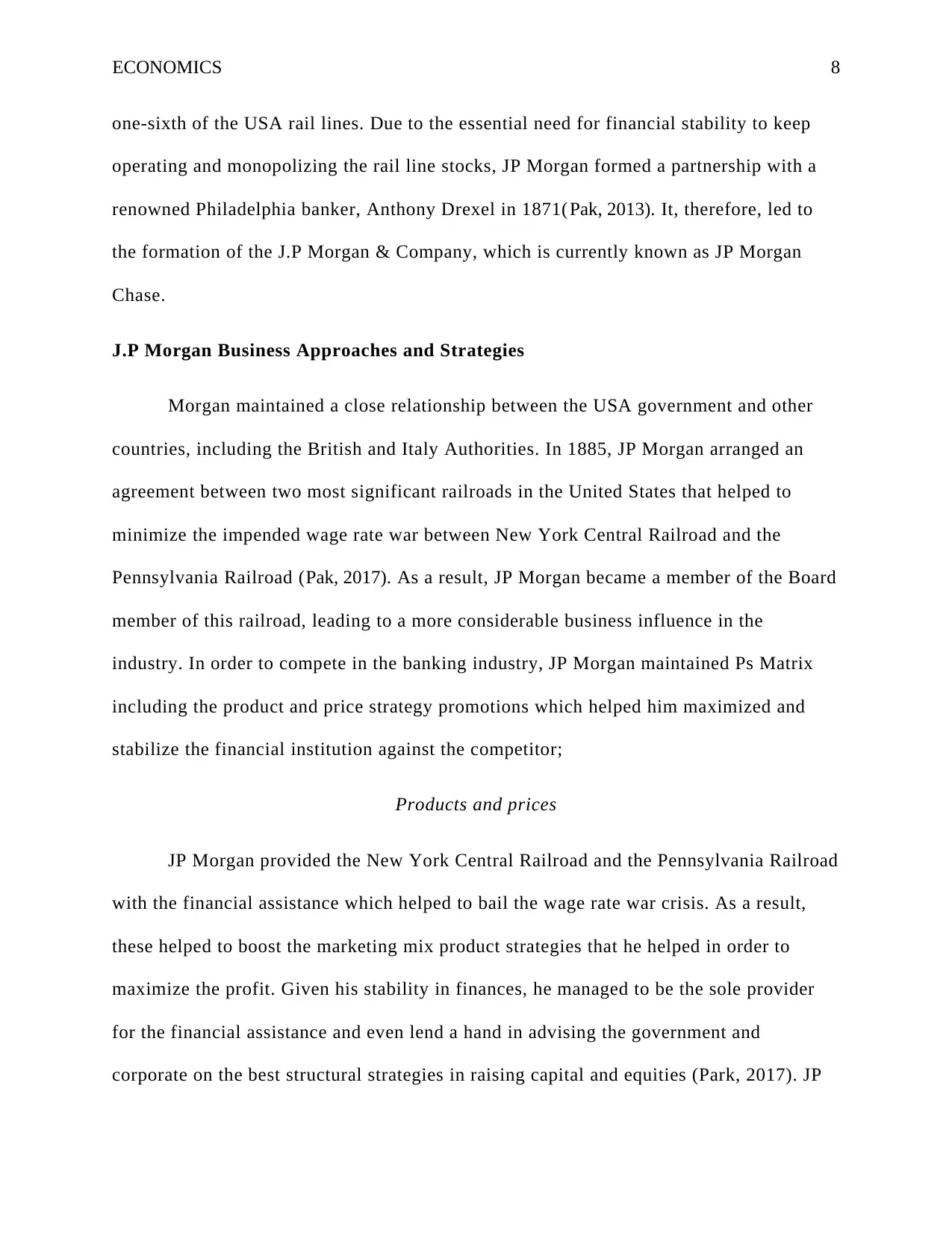
ECONOMICS 8
one-sixth of the USA rail lines. Due to the essential need for financial stability to keep
operating and monopolizing the rail line stocks, JP Morgan formed a partnership with a
renowned Philadelphia banker, Anthony Drexel in 1871( Pak, 2013). It, therefore, led to
the formation of the J.P Morgan & Company, which is currently known as JP Morgan
Chase.
J.P Morgan Business Approaches and Strategies
Morgan maintained a close relationship between the USA government and other
countries, including the British and Italy Authorities. In 1885, JP Morgan arranged an
agreement between two most significant railroads in the United States that helped to
minimize the impended wage rate war between New York Central Railroad and the
Pennsylvania Railroad (Pak, 2017). As a result, JP Morgan became a member of the Board
member of this railroad, leading to a more considerable business influence in the
industry. In order to compete in the banking industry, JP Morgan maintained Ps Matrix
including the product and price strategy promotions which helped him maximized and
stabilize the financial institution against the competitor;
Products and prices
JP Morgan provided the New York Central Railroad and the Pennsylvania Railroad
with the financial assistance which helped to bail the wage rate war crisis. As a result,
these helped to boost the marketing mix product strategies that he helped in order to
maximize the profit. Given his stability in finances, he managed to be the sole provider
for the financial assistance and even lend a hand in advising the government and
corporate on the best structural strategies in raising capital and equities (Park, 2017). JP
one-sixth of the USA rail lines. Due to the essential need for financial stability to keep
operating and monopolizing the rail line stocks, JP Morgan formed a partnership with a
renowned Philadelphia banker, Anthony Drexel in 1871( Pak, 2013). It, therefore, led to
the formation of the J.P Morgan & Company, which is currently known as JP Morgan
Chase.
J.P Morgan Business Approaches and Strategies
Morgan maintained a close relationship between the USA government and other
countries, including the British and Italy Authorities. In 1885, JP Morgan arranged an
agreement between two most significant railroads in the United States that helped to
minimize the impended wage rate war between New York Central Railroad and the
Pennsylvania Railroad (Pak, 2017). As a result, JP Morgan became a member of the Board
member of this railroad, leading to a more considerable business influence in the
industry. In order to compete in the banking industry, JP Morgan maintained Ps Matrix
including the product and price strategy promotions which helped him maximized and
stabilize the financial institution against the competitor;
Products and prices
JP Morgan provided the New York Central Railroad and the Pennsylvania Railroad
with the financial assistance which helped to bail the wage rate war crisis. As a result,
these helped to boost the marketing mix product strategies that he helped in order to
maximize the profit. Given his stability in finances, he managed to be the sole provider
for the financial assistance and even lend a hand in advising the government and
corporate on the best structural strategies in raising capital and equities (Park, 2017). JP
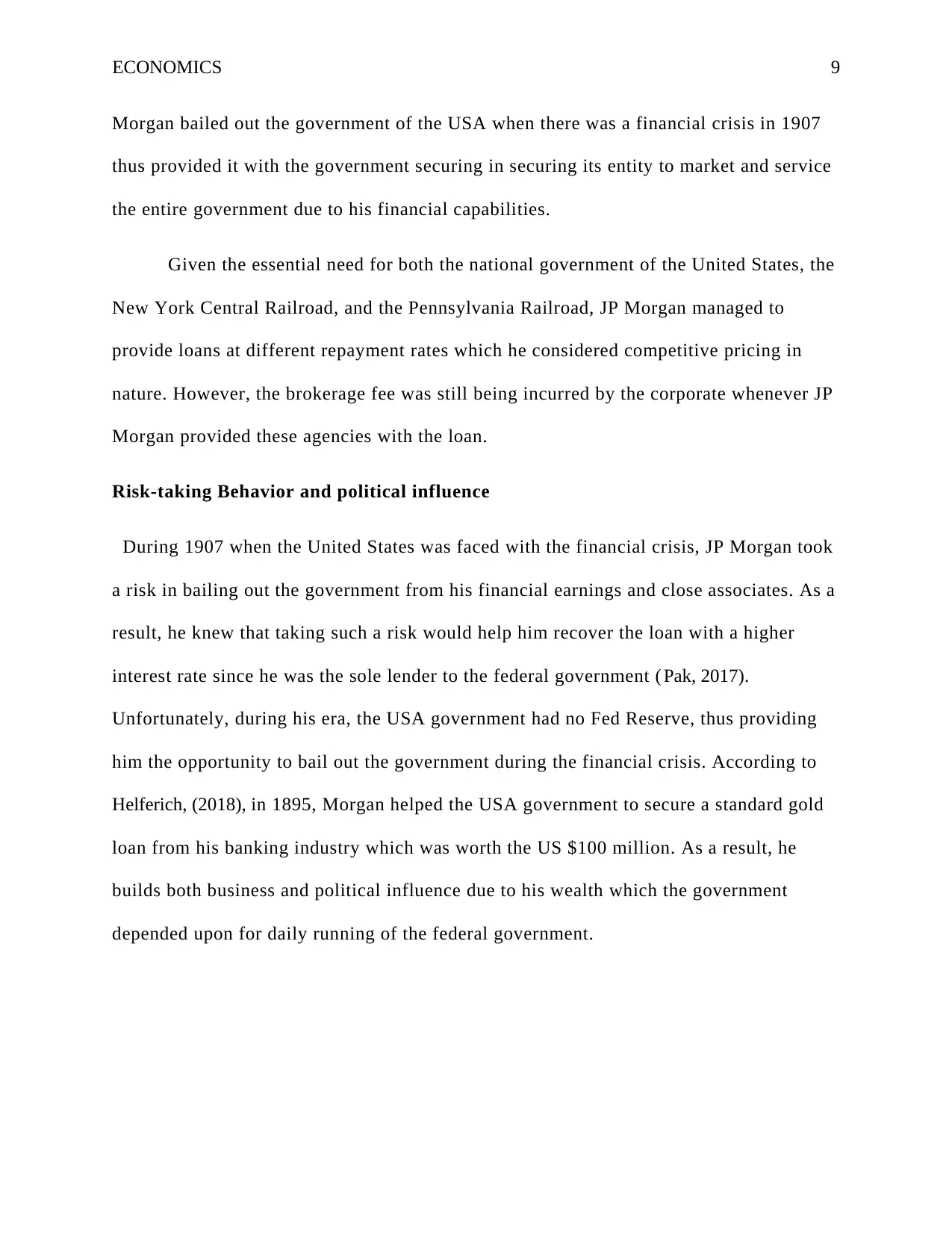
ECONOMICS 9
Morgan bailed out the government of the USA when there was a financial crisis in 1907
thus provided it with the government securing in securing its entity to market and service
the entire government due to his financial capabilities.
Given the essential need for both the national government of the United States, the
New York Central Railroad, and the Pennsylvania Railroad, JP Morgan managed to
provide loans at different repayment rates which he considered competitive pricing in
nature. However, the brokerage fee was still being incurred by the corporate whenever JP
Morgan provided these agencies with the loan.
Risk-taking Behavior and political influence
During 1907 when the United States was faced with the financial crisis, JP Morgan took
a risk in bailing out the government from his financial earnings and close associates. As a
result, he knew that taking such a risk would help him recover the loan with a higher
interest rate since he was the sole lender to the federal government ( Pak, 2017).
Unfortunately, during his era, the USA government had no Fed Reserve, thus providing
him the opportunity to bail out the government during the financial crisis. According to
Helferich, (2018), in 1895, Morgan helped the USA government to secure a standard gold
loan from his banking industry which was worth the US $100 million. As a result, he
builds both business and political influence due to his wealth which the government
depended upon for daily running of the federal government.
Morgan bailed out the government of the USA when there was a financial crisis in 1907
thus provided it with the government securing in securing its entity to market and service
the entire government due to his financial capabilities.
Given the essential need for both the national government of the United States, the
New York Central Railroad, and the Pennsylvania Railroad, JP Morgan managed to
provide loans at different repayment rates which he considered competitive pricing in
nature. However, the brokerage fee was still being incurred by the corporate whenever JP
Morgan provided these agencies with the loan.
Risk-taking Behavior and political influence
During 1907 when the United States was faced with the financial crisis, JP Morgan took
a risk in bailing out the government from his financial earnings and close associates. As a
result, he knew that taking such a risk would help him recover the loan with a higher
interest rate since he was the sole lender to the federal government ( Pak, 2017).
Unfortunately, during his era, the USA government had no Fed Reserve, thus providing
him the opportunity to bail out the government during the financial crisis. According to
Helferich, (2018), in 1895, Morgan helped the USA government to secure a standard gold
loan from his banking industry which was worth the US $100 million. As a result, he
builds both business and political influence due to his wealth which the government
depended upon for daily running of the federal government.
⊘ This is a preview!⊘
Do you want full access?
Subscribe today to unlock all pages.

Trusted by 1+ million students worldwide
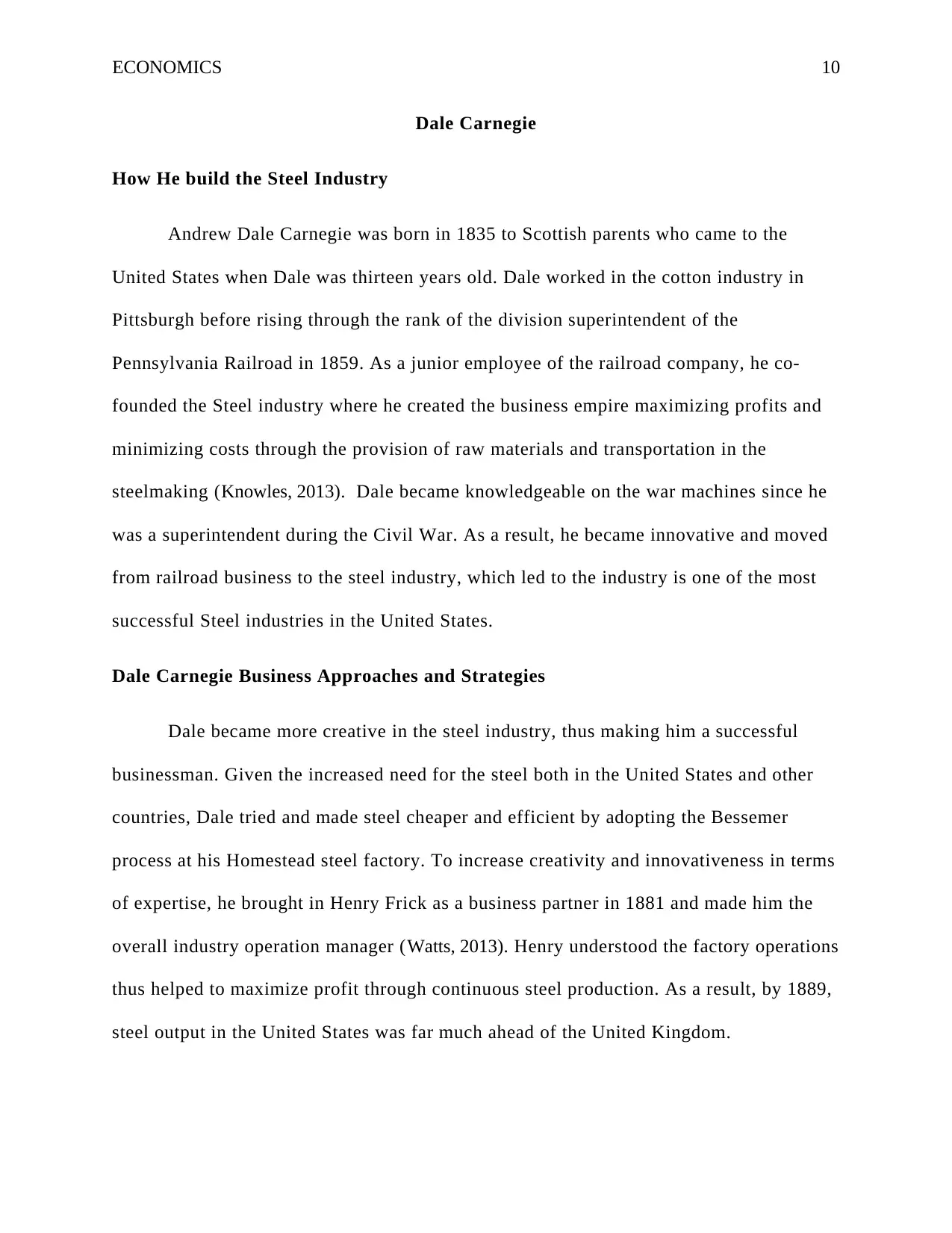
ECONOMICS 10
Dale Carnegie
How He build the Steel Industry
Andrew Dale Carnegie was born in 1835 to Scottish parents who came to the
United States when Dale was thirteen years old. Dale worked in the cotton industry in
Pittsburgh before rising through the rank of the division superintendent of the
Pennsylvania Railroad in 1859. As a junior employee of the railroad company, he co-
founded the Steel industry where he created the business empire maximizing profits and
minimizing costs through the provision of raw materials and transportation in the
steelmaking (Knowles, 2013). Dale became knowledgeable on the war machines since he
was a superintendent during the Civil War. As a result, he became innovative and moved
from railroad business to the steel industry, which led to the industry is one of the most
successful Steel industries in the United States.
Dale Carnegie Business Approaches and Strategies
Dale became more creative in the steel industry, thus making him a successful
businessman. Given the increased need for the steel both in the United States and other
countries, Dale tried and made steel cheaper and efficient by adopting the Bessemer
process at his Homestead steel factory. To increase creativity and innovativeness in terms
of expertise, he brought in Henry Frick as a business partner in 1881 and made him the
overall industry operation manager (Watts, 2013). Henry understood the factory operations
thus helped to maximize profit through continuous steel production. As a result, by 1889,
steel output in the United States was far much ahead of the United Kingdom.
Dale Carnegie
How He build the Steel Industry
Andrew Dale Carnegie was born in 1835 to Scottish parents who came to the
United States when Dale was thirteen years old. Dale worked in the cotton industry in
Pittsburgh before rising through the rank of the division superintendent of the
Pennsylvania Railroad in 1859. As a junior employee of the railroad company, he co-
founded the Steel industry where he created the business empire maximizing profits and
minimizing costs through the provision of raw materials and transportation in the
steelmaking (Knowles, 2013). Dale became knowledgeable on the war machines since he
was a superintendent during the Civil War. As a result, he became innovative and moved
from railroad business to the steel industry, which led to the industry is one of the most
successful Steel industries in the United States.
Dale Carnegie Business Approaches and Strategies
Dale became more creative in the steel industry, thus making him a successful
businessman. Given the increased need for the steel both in the United States and other
countries, Dale tried and made steel cheaper and efficient by adopting the Bessemer
process at his Homestead steel factory. To increase creativity and innovativeness in terms
of expertise, he brought in Henry Frick as a business partner in 1881 and made him the
overall industry operation manager (Watts, 2013). Henry understood the factory operations
thus helped to maximize profit through continuous steel production. As a result, by 1889,
steel output in the United States was far much ahead of the United Kingdom.
Paraphrase This Document
Need a fresh take? Get an instant paraphrase of this document with our AI Paraphraser
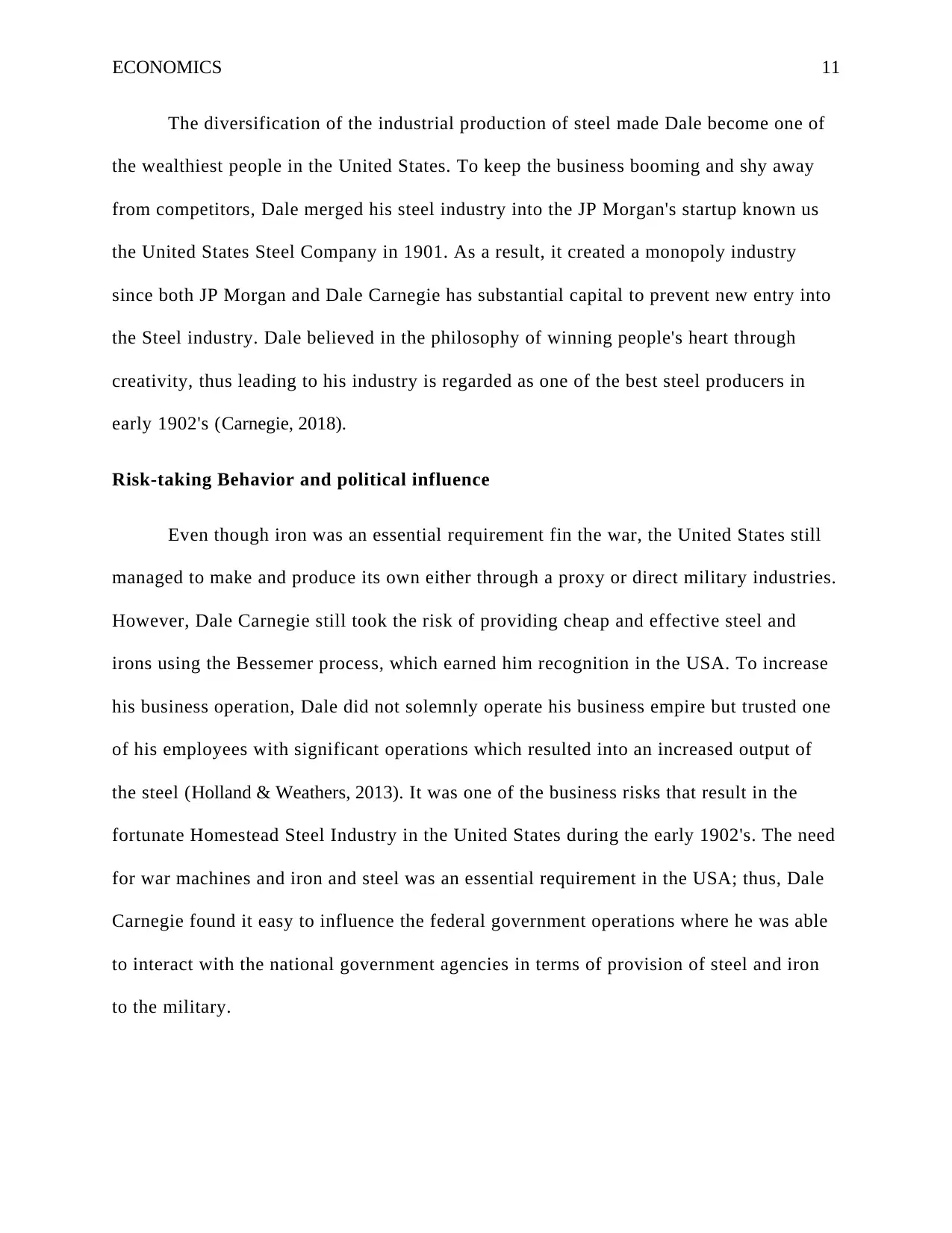
ECONOMICS 11
The diversification of the industrial production of steel made Dale become one of
the wealthiest people in the United States. To keep the business booming and shy away
from competitors, Dale merged his steel industry into the JP Morgan's startup known us
the United States Steel Company in 1901. As a result, it created a monopoly industry
since both JP Morgan and Dale Carnegie has substantial capital to prevent new entry into
the Steel industry. Dale believed in the philosophy of winning people's heart through
creativity, thus leading to his industry is regarded as one of the best steel producers in
early 1902's (Carnegie, 2018).
Risk-taking Behavior and political influence
Even though iron was an essential requirement fin the war, the United States still
managed to make and produce its own either through a proxy or direct military industries.
However, Dale Carnegie still took the risk of providing cheap and effective steel and
irons using the Bessemer process, which earned him recognition in the USA. To increase
his business operation, Dale did not solemnly operate his business empire but trusted one
of his employees with significant operations which resulted into an increased output of
the steel (Holland & Weathers, 2013). It was one of the business risks that result in the
fortunate Homestead Steel Industry in the United States during the early 1902's. The need
for war machines and iron and steel was an essential requirement in the USA; thus, Dale
Carnegie found it easy to influence the federal government operations where he was able
to interact with the national government agencies in terms of provision of steel and iron
to the military.
The diversification of the industrial production of steel made Dale become one of
the wealthiest people in the United States. To keep the business booming and shy away
from competitors, Dale merged his steel industry into the JP Morgan's startup known us
the United States Steel Company in 1901. As a result, it created a monopoly industry
since both JP Morgan and Dale Carnegie has substantial capital to prevent new entry into
the Steel industry. Dale believed in the philosophy of winning people's heart through
creativity, thus leading to his industry is regarded as one of the best steel producers in
early 1902's (Carnegie, 2018).
Risk-taking Behavior and political influence
Even though iron was an essential requirement fin the war, the United States still
managed to make and produce its own either through a proxy or direct military industries.
However, Dale Carnegie still took the risk of providing cheap and effective steel and
irons using the Bessemer process, which earned him recognition in the USA. To increase
his business operation, Dale did not solemnly operate his business empire but trusted one
of his employees with significant operations which resulted into an increased output of
the steel (Holland & Weathers, 2013). It was one of the business risks that result in the
fortunate Homestead Steel Industry in the United States during the early 1902's. The need
for war machines and iron and steel was an essential requirement in the USA; thus, Dale
Carnegie found it easy to influence the federal government operations where he was able
to interact with the national government agencies in terms of provision of steel and iron
to the military.
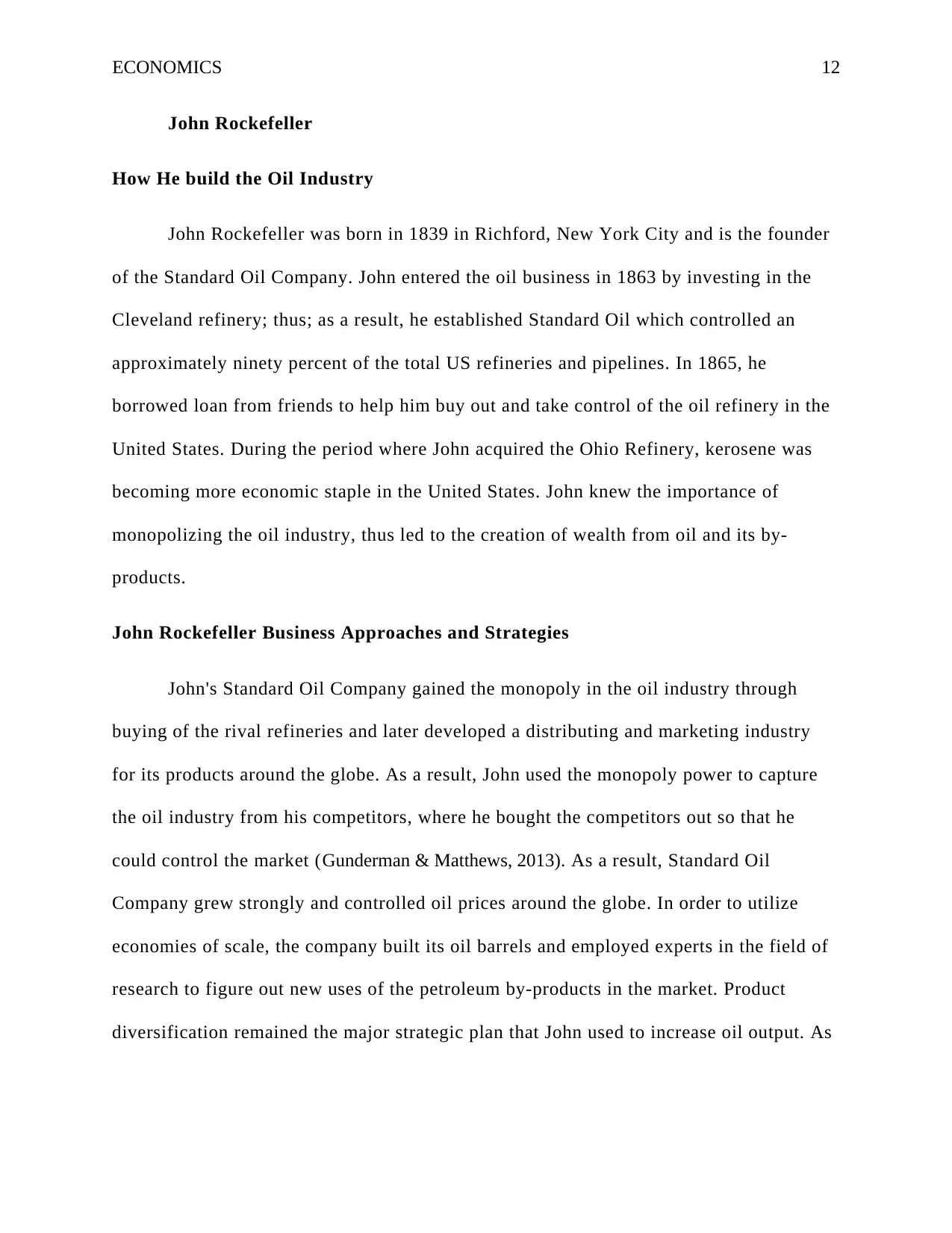
ECONOMICS 12
John Rockefeller
How He build the Oil Industry
John Rockefeller was born in 1839 in Richford, New York City and is the founder
of the Standard Oil Company. John entered the oil business in 1863 by investing in the
Cleveland refinery; thus; as a result, he established Standard Oil which controlled an
approximately ninety percent of the total US refineries and pipelines. In 1865, he
borrowed loan from friends to help him buy out and take control of the oil refinery in the
United States. During the period where John acquired the Ohio Refinery, kerosene was
becoming more economic staple in the United States. John knew the importance of
monopolizing the oil industry, thus led to the creation of wealth from oil and its by-
products.
John Rockefeller Business Approaches and Strategies
John's Standard Oil Company gained the monopoly in the oil industry through
buying of the rival refineries and later developed a distributing and marketing industry
for its products around the globe. As a result, John used the monopoly power to capture
the oil industry from his competitors, where he bought the competitors out so that he
could control the market (Gunderman & Matthews, 2013). As a result, Standard Oil
Company grew strongly and controlled oil prices around the globe. In order to utilize
economies of scale, the company built its oil barrels and employed experts in the field of
research to figure out new uses of the petroleum by-products in the market. Product
diversification remained the major strategic plan that John used to increase oil output. As
John Rockefeller
How He build the Oil Industry
John Rockefeller was born in 1839 in Richford, New York City and is the founder
of the Standard Oil Company. John entered the oil business in 1863 by investing in the
Cleveland refinery; thus; as a result, he established Standard Oil which controlled an
approximately ninety percent of the total US refineries and pipelines. In 1865, he
borrowed loan from friends to help him buy out and take control of the oil refinery in the
United States. During the period where John acquired the Ohio Refinery, kerosene was
becoming more economic staple in the United States. John knew the importance of
monopolizing the oil industry, thus led to the creation of wealth from oil and its by-
products.
John Rockefeller Business Approaches and Strategies
John's Standard Oil Company gained the monopoly in the oil industry through
buying of the rival refineries and later developed a distributing and marketing industry
for its products around the globe. As a result, John used the monopoly power to capture
the oil industry from his competitors, where he bought the competitors out so that he
could control the market (Gunderman & Matthews, 2013). As a result, Standard Oil
Company grew strongly and controlled oil prices around the globe. In order to utilize
economies of scale, the company built its oil barrels and employed experts in the field of
research to figure out new uses of the petroleum by-products in the market. Product
diversification remained the major strategic plan that John used to increase oil output. As
⊘ This is a preview!⊘
Do you want full access?
Subscribe today to unlock all pages.

Trusted by 1+ million students worldwide
1 out of 15
Your All-in-One AI-Powered Toolkit for Academic Success.
+13062052269
info@desklib.com
Available 24*7 on WhatsApp / Email
![[object Object]](/_next/static/media/star-bottom.7253800d.svg)
Unlock your academic potential
Copyright © 2020–2025 A2Z Services. All Rights Reserved. Developed and managed by ZUCOL.


